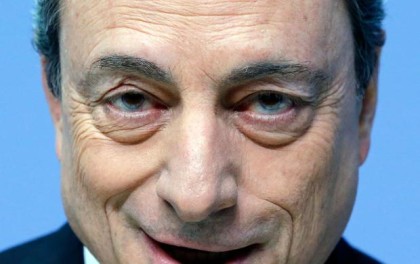
FRANKFURT, Germany (AP) — European Central Bank launched an unexpectedly broad array of stimulus measures Thursday aimed at boosting a modest economic recovery in the 19 countries that use the euro and nudging up dangerously low inflation. The ECB, the monetary authority for the euro countries, is struggling to raise inflation from a worryingly low annual rate of minus 0.2 percent toward its goal of just under 2 percent, considered healthiest for the economy.ECB President Mario Draghi said the bank’s decisions at the meeting of its 25-member governing council were the best answer to recent questions about whether central banks were reaching the limits of what they can do.
Must control the inflation
-We don’t give up in our fight to bring inflation back to our objective, Mario Draghi said. He added that the steps to increase bank lending would «reinforce the momentum of the euro area’s economic recovery and accelerate the return of inflation to levels below, but close to, 2 percent.The market’s reaction was volatile. The Stoxx Europe 50 blue chip index ended 1.8 percent lower after spiking higher earlier. The euro rose 1.5 percent to around $1.11 — though it usually falls in response to more stimulus. Laith Khalaf, senior analyst at stockbrokers Hargreaves Lansdown, said the use of ever more unusual stimulus measures was hard to see as positive. He said the fact the ECB is «still pursuing such extreme monetary policy paints a depressing picture of the European economy.» Investors, he adds, «are beginning to question what central banks have left in the locker if the global economy slips back towards recession.»
More economic malaise
More economic malaise in Europe is the last thing the global economy needs. The region is a key market for major companies, from automakers Ford and General Motors to technology companies Apple and Samsung. Trouble in Europe would compound woes from slowing growth in many parts of the world, particularly China. The ECB’s stimulus efforts over the past year seemed a long way away for Portuguese pensioner Dolores Tavares. «I haven’t noticed any difference in my life,» Tavares said as she and her husband put the shopping in their car trunk outside a Lisbon vegetable market. «I don’t expect the benefits to reach me anyway. All that will be for the big financial people, not people like us.» In Spain, Enrique Quero took a more upbeat view. «These measures have more of an overall global effect and, yes, are positive in general for society and for markets, although they don*t affect people directly,» said Quero, 42, who works in an employee recruitment agency in Madrid. «In Spain, they have a good influence on investments and helping getting money moving because they liven up markets.»
Will impress the markets
The breadth of Thursday’s measures suggests the ECB was determined to impress markets, which had been underwhelmed by the bank’s last package of stimulus in December. Here’s what the ECB did: — It cut its main benchmark rate to zero from 0.05 percent Lowered the rate on deposits from commercial banks at the central bank to minus 0.40 percent from minus 0.30 percent, an unconventional move aimed at pushing banks to lend rather than hoard cash — Boosted its monthly bond purchases to 80 billion euros ($88 billion) from 60 billion euros, pushing more newly printed money into the economy
— Added corporate bonds to the assets it can buy, expanding the potential scope of the stimulus program — And announced long-term loans at zero or negative interest of up to four years to help support banks. The negative rate on deposits is an unusual step aimed at pushing banks to lend rather than leave money at the central bank. More lending would in theory promote growth and push up inflation. Alasdair Cavalla at the Centre for Economics and Business Research in London suggested that the latest ECB steps were comparable to the last stage of U.S. Federal Reserve’s stimulus efforts that promised open-ended stimulus until unemployment fell. The Fed has ended its stimulus efforts and has made a first interest rate increase, as the U.S. economy has strengthened.
Far more cautious
– The ECB has been far more cautious than the Fed throughout the Great Recession, and may at last be realizing that this may have at least something to do with the divergence in economic performance since then,» Cavalla wrote in an email. Yet the ECB’s cut of the deposit rate below zero — also deployed by central banks in Japan, Denmark, Switzerland and elsewhere — has raised fears of side effects, in particular that it could dent bank profits. The cheap loans appear aimed at removing that concern. Having healthy banks is crucial because they provide most business financing in Europe — a contrast with the United States, where most business credit comes from financial markets. Also, weak banks don’t lend.
Can`t push up inflation
Despite unconventional measures such as negative rates, central banks in Europe, Japan, the United States and elsewhere have had little luck recently in pushing up inflation. The Bank for International Settlements, an international organization of central banks, said in a report Sunday that central bank policies were reaching their limit. Many economists say that the key to boosting global growth must come from governments spending more and tackling the obstacles to growth in their own economies. That would include clearing away regulation that makes it hard to start a business and excessive employee protections that make companies reluctant to hire in the first place, reports Associated Press.President of European Central Bank Mario Draghi speaks during a press conference following a meeting of the governing council in Frankfurt, Germany, Thursday, March 10, 2016. The European Central Bank cut all its main interest rates, expanded its bond-buying stimulus program, and offered new cheap loans to banks, making an unexpectedly aggressive effort to boost inflation and economic growth in the 19 countries that share the euro, according to Associated Press in Frankfurt.




